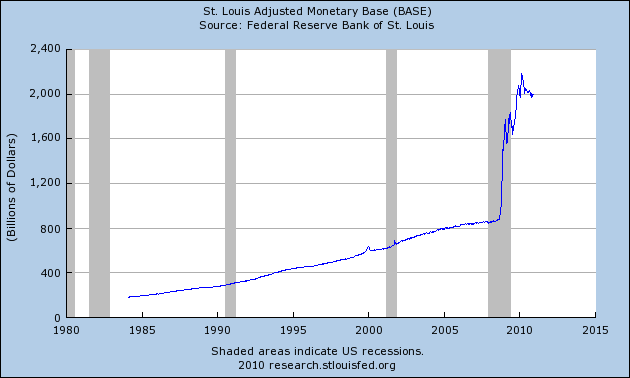 If you only watch the “economic pundits” on television, it can be very confusing to figure out exactly what is happening with the U.S. economy. One pundit will pull out a couple statistics that got a little bit better over the past month and claim that we have entered a time of solid recovery. Another pundit will pull out a couple statistics that got a little worse over the past month and claim that we are headed for trouble. So what is the truth? Well, if you really want to get a clear idea of what is really going on you have to look at the long-term trends. There are some economic trends which just keep getting worse year after year after year, and it is those trends that tell the real story of the decline of our economic system.
If you only watch the “economic pundits” on television, it can be very confusing to figure out exactly what is happening with the U.S. economy. One pundit will pull out a couple statistics that got a little bit better over the past month and claim that we have entered a time of solid recovery. Another pundit will pull out a couple statistics that got a little worse over the past month and claim that we are headed for trouble. So what is the truth? Well, if you really want to get a clear idea of what is really going on you have to look at the long-term trends. There are some economic trends which just keep getting worse year after year after year, and it is those trends that tell the real story of the decline of our economic system.
As you examine the long-term trends, you quickly come to realize that the U.S. is trapped in an endless spiral of debt, the middle class is being wiped out, the U.S. dollar is being destroyed and America is rapidly becoming a post-industrial wasteland.
Posted below are 16 nightmarish economic trends to watch carefully in 2011. It is becoming exceedingly apparent that unless something is done rapidly we are heading for an economic collapse of unprecedented magnitude….
#1 Do you want to see something scary? Just check out the chart below. Since the beginning of the economic downturn, the U.S. monetary base has more than doubled. But don’t worry – Federal Reserve Chairman Ben Bernanke has promised us that this could never cause inflation. In fact, Bernanke says that we need to inject even more dollars into the economy. So if you are alarmed by the chart below, you are just being irrational according to Bernanke….
#2 Thousands of our factories, millions of our jobs and hundreds of billions of dollars of our national wealth continue to be shipped overseas. In 1985, the U.S. trade deficit with China was 6 million dollars for the entire year. In the month of August alone, the U.S. trade deficit with China was over 28 billion dollars. Nobel economist Robert W. Fogel of the University of Chicago is projecting that the Chinese economy will be three times larger than the U.S. economy by the year 2040 if current trends continue.
#3 The United States is rapidly becoming a post-industrial wasteland. Back in 1959, manufacturing represented 28 percent of all U.S. economic output. In 2008, it represented only 11.5 percent and it continues to fall. Sadly, the truth is that America is being deindustrialized. As of the end of 2009, less than 12 million Americans worked in manufacturing. The last time that less than 12 million Americans were employed in manufacturing was in 1941.
#4 The number of Americans that have been out of work for an extended period of time has absolutely exploded over the last few years. As 2007 began, there were just over 1 million Americans that had been unemployed for half a year or longer. Today, there are over 6 million Americans that have been unemployed for half a year or longer.
#5 The middle class continues to be squeezed out of existence. According to a poll taken in 2009, 61 percent of Americans “always or usually” live paycheck to paycheck. That was up substantially from 49 percent in 2008 and 43 percent in 2007.
#6 The number of Americans living in poverty is absolutely skyrocketing. 42.9 million Americans are now on food stamps, and one out of every six Americans is now enrolled in at least one anti-poverty program run by the federal government. Unfortunately, many of those that have been hardest hit by this economic downturn have been children. According to one new study, approximately 21 percent of all children in the United States are living below the poverty line in 2010 – the highest rate in 20 years.
#7 Many American families have been pushed beyond the breaking point during this economic downturn. Over 1.4 million Americans filed for personal bankruptcy in 2009, which represented a 32 percent increase over 2008. The final number for 2010 is expected to be even higher.
#8 The U.S. real estate market continues to stagnate. During the third quarter of 2010, 67 percent of mortgages in Nevada were “underwater”, 49 percent of mortgages in Arizona were “underwater” and 46 percent of mortgages in Florida were “underwater”. So what happens if home prices go down even more?
#9 More elderly Americans than ever are being forced to put off retirement and continue working. In 2010, 55 percent of Americans between the ages of 60 and 64 were in the labor market. Ten years ago, that number was just 47 percent. Unfortunately, it looks like this problem will only get worse in the years ahead. In America today, approximately half of all workers have less than $2000 saved up for retirement.
#10 In the United States today, there are simply far too many retirees and not nearly enough workers to support them. Back in 1950 each retiree’s Social Security benefit was paid for by 16 workers. Today, each retiree’s Social Security benefit is paid for by approximately 3.3 workers. By 2025 it is projected that there will be approximately two workers for each retiree.
#11 Financial assets continue to become concentrated in fewer and fewer hands. For example, the “big four” U.S. banks (Citigroup, JPMorgan Chase, Bank of America and Wells Fargo) had approximately 22 percent of all deposits in FDIC-insured institutions back in 2000. As of the middle of 2009 that figure was up to 39 percent.
#12 The Federal Reserve has been destroying the value of the U.S. dollar for decades. Since the Federal Reserve was created in 1913, the U.S. dollar has lost over 95 percent of its purchasing power. An item that cost $20.00 in 1970 would cost you $112.35 today. An item that cost $20.00 in 1913 would cost you $440.33 today.
#13 Commodity prices continue to soar into the stratosphere. Ten years ago, the price of a barrel of oil hovered around 20 to 30 dollars most of the time. Today, the price of oil is rapidly closing in on 100 dollars a barrel and there are now fears that it could soon go much higher than that.
#14 Federal government spending is completely and totally out of control. The U.S. government budget deficit increased to a whopping $150.4 billion last month, which represented the biggest November deficit on record. But our politicians can’t seem to break their addiction to debt. In fact, Democrats are trying to ram through a 1,924 page, 1.1 trillion dollar spending bill in the final days of the lame-duck session of Congress before the Republicans take control of the House of Representatives next year.
#15 The U.S. national debt is rapidly closing in on 14 trillion dollars. It is more than 13 times larger than it was just 30 short years ago. According to an official U.S. Treasury Department report to Congress, the U.S. national debt is projected to climb to an estimated $19.6 trillion by 2015.
#16 Unfortunately, the official government numbers grossly understate the horrific nature of the crisis we are facing. John Williams of Shadow Government Statistics has calculated that if the federal government would have used GAAP accounting standards to measure the federal budget deficit for 2009, it would have been approximately 8.8 trillion dollars. Not only that, but John Williams now says that U.S. government debt is so wildly out of control that it is mathematically impossible for us to “grow” our way out of it….
The government’s finances not only are out of control, but the actual deficit is not containable. Put into perspective, if the government were to raise taxes so as to seize 100% of all wages, salaries and corporate profits, it still would be showing an annual deficit using GAAP accounting on a consistent basis. In like manner, given current revenues, if it stopped spending every penny (including defense and homeland security) other than for Social Security and Medicare obligations, the government still would be showing an annual deficit. Further, the U.S. has no potential way to grow out of this shortfall.
The more one examines the U.S. economic situation, the more depressing it becomes. The U.S. financial system is trapped inside a horrific debt spiral and we are headed straight for economic oblivion.
If our leaders attempt to interrupt the debt spiral it will plunge our economy into a depression. If our leaders attempt to keep the debt spiral going for several more years it will just make the eventual crash even worse. Either way, we are headed for a financial implosion that will be truly historic.
The debt-fueled good times that we have been enjoying for the last several decades are rapidly coming to an end. Unfortunately for the tens of millions of Americans that are already suffering, our economic problems are only going to get worse in the years ahead.
So what do you think? Do you agree that the U.S. economy is doomed? Please feel free to leave a comment with your opinion….
